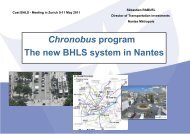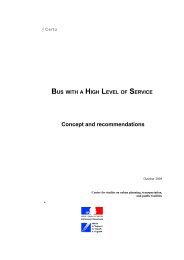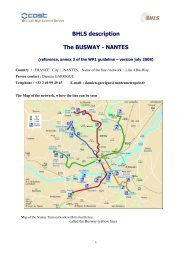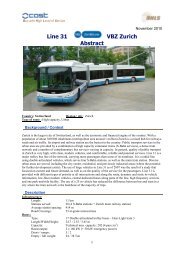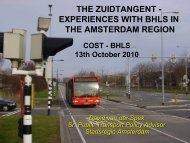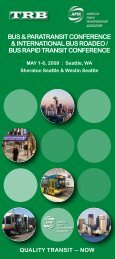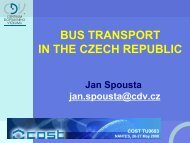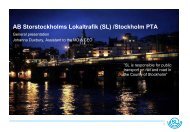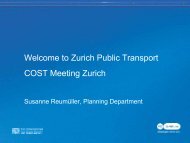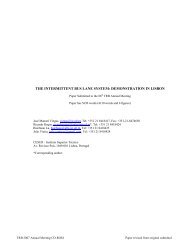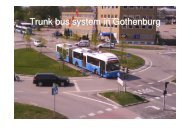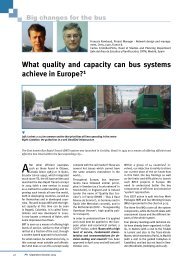Description template for a BHLS
Description template for a BHLS
Description template for a BHLS
You also want an ePaper? Increase the reach of your titles
YUMPU automatically turns print PDFs into web optimized ePapers that Google loves.
Bus with High Level of Service<br />
<strong>BHLS</strong> description<br />
Züri Linie - Zurich<br />
(Reference, annex of the WP1 guideline – version October 2009)<br />
Country: Switzerland City: Zurich Name of the line / network: Route 31<br />
Person contact: Nelson Carrasco<br />
Telephone: + 41 44 633 3087 E-mail: carrasco@ivt.baug.ethz.ch<br />
The Map of the network, where the line can be seen<br />
- Yes ; N – No ; P – Partial ; I – Insufficient network to make a conclusion ; NA – Not applicable<br />
1
Bus with High Level of Service<br />
1 – The urban and governance context<br />
The main data of the urban area context<br />
Answer<br />
If needed: some comments or<br />
explaination<br />
Number of communities 1<br />
Number of inhabitant of this urban area 365’000<br />
Total surface of this urban area 92 Km 2<br />
Density Inhabitants per Km 2 (and if possible density of the<br />
downtown)<br />
http://www.demographia.com/db-zurward.htm<br />
PT market split rate (Zurich)<br />
4’100 entire city<br />
3’100 downtown<br />
50% <strong>for</strong> all PT<br />
modes<br />
VBZ operates in the city of<br />
Zurich, but the operation is<br />
integrated at a regional level<br />
with the Zurich Public<br />
Transport Authority (ZVV)<br />
Zurich city, not including<br />
agglomeration<br />
Downtown refers to Kreis 1<br />
Slow modes not included.<br />
Commuter trip data from 2000<br />
(source: strasse und verkehr 12/05)<br />
Trips / inhabitant / day 3.3 All modes (MZ 2005)<br />
Average of Km / inhabitant / year (all of Switzerland):<br />
- All modes<br />
- Buses & Trams<br />
- Other main mode (Private cars)<br />
13’932<br />
547<br />
9’324<br />
Source: MZ 2005<br />
Operating cost coverage rate (all transport modes) 64 % Source: ZVV financial report (2007)<br />
The background: context of the project implementation<br />
and decision process.<br />
What was the basis <strong>for</strong> the stimulus of the project?<br />
- Is it a part of a mobility master plan?<br />
- Is it an upgrading existing bus line?<br />
What are the main objectives at the level of the whole<br />
urban area?<br />
Who was the promoter/initiator of introducing the <strong>BHLS</strong><br />
project?<br />
Main dates of the project<br />
- creation of the mobility master :<br />
- feasibility studies:<br />
- decision to proceed:<br />
- start construction:<br />
- end construction:<br />
- opening year:<br />
Answer<br />
<br />
No<br />
If needed: some comments or explaination<br />
Mobility makes part of a citywide (and<br />
regional) master development plan <strong>for</strong> 2025.<br />
Bus lines complement the tram and S-Bahn<br />
network in the city<br />
-Improve quality of life<br />
-Efficiency, culture innovation, security (PT)<br />
-Increase attractiveness and expand network<br />
<strong>for</strong> PT and Slow modes<br />
-Highest possible quality in the service<br />
(certified)<br />
(Kantonsrat) (Regierungsrat)<br />
(Verkehrsverbund)<br />
(Verkehrsunernehmen)<br />
The bus line 31 is not con<strong>template</strong>d as a<br />
separate element in the PT strategy.<br />
2
Bus with High Level of Service<br />
Was there a system choice debate between <strong>BHLS</strong> / tram<br />
system / metro system?<br />
Have there been in the past (70-80-90) trials to implement<br />
an “upgraded’’ bus line or have there been projects that<br />
could be seen as <strong>for</strong>erunners of <strong>BHLS</strong>?<br />
The <strong>BHLS</strong> communication / marketing process<br />
What were main difficulties to overcome when trying to<br />
implement?<br />
Were they (with some short explanation if yes):<br />
- technical ?<br />
- political ?<br />
- social ?<br />
- economic ?<br />
How were user needs assessed/collected?<br />
- surveys done<br />
- process to talk<br />
To know if user groups were requested <strong>for</strong> designing the<br />
project, and how it has been managed.<br />
- in case remarks taken in account:<br />
Specific elements (arguments) that made the project<br />
adopted<br />
(source: Objectives of VBZ strategy 2007-2010)<br />
The main socio-eco key indicators used to justify the <strong>BHLS</strong><br />
systems, what were they ?<br />
Integration in land development ?<br />
Cost of the global project / km (including P+R, interchange<br />
stations, …)<br />
How was the project financed?<br />
Source of funds (results in % )<br />
- Public funds (state, local authority)<br />
- Part of PPP<br />
- Financement by land development<br />
- Transport operator<br />
Tendering: was the <strong>BHLS</strong> project tendered and if yes was it<br />
done like a turn-key (infra+vehicles) at the same time or<br />
vehicles separated?<br />
Other (describe)<br />
<br />
<br />
<br />
<br />
N<br />
N<br />
<br />
I<br />
This bus line replaced a Tram line in 1958,<br />
there are plans to re-convert it to a tram line,<br />
but not be<strong>for</strong>e 2025.<br />
The strategy is to constantly evaluate and<br />
upgrade infrastructure, vehicles, technology<br />
and operations; to <strong>for</strong>mulate long term<br />
strategies according to the development of<br />
the city, and to constantly improve service<br />
quality and customer satisfaction<br />
- System is advertised as a whole, not only<br />
buses or individual lines.<br />
- Emphasis on customer service at selling<br />
points.<br />
See Nash (2003)<br />
Questionnaires filled by operators, surveys<br />
completed by users and by independent<br />
evaluations by the Tourism association<br />
(Quality assurance)<br />
- Capture increasing demand <strong>for</strong> mobility in<br />
a sustainable way<br />
- Increase capacity in current and short term<br />
bottleneck points<br />
- Increase customer satisfaction<br />
- Promote modal shift to PT and slow modes<br />
- Sustainable mobility<br />
- Increase attractiveness and competitiveness<br />
of Zurich in national and international level<br />
-Reduce pollution generated by noise and<br />
emissions<br />
-Improve quality of life<br />
In accordance with Zürich’s Spatial<br />
development strategy and Europaallee<br />
project to be completed in 2019<br />
3
Bus with High Level of Service<br />
Network concerns<br />
Is it a main route of the network?<br />
(Route 31)<br />
Is it a feeder route to the heavy mass transit systems?<br />
Number of connecting point with the structuring<br />
network<br />
Existence of an integrated “network” of several <strong>BHLS</strong><br />
routes<br />
Number of <strong>BHLS</strong> lines<br />
Do provide the network map with the <strong>BHLS</strong> lines<br />
Do provide few photographs of the <strong>BHLS</strong> system<br />
<br />
<br />
One of the main bus routes of the network. First bus<br />
route in the city to introduce double articulated<br />
trolley buses in 2007<br />
Offers connection to four S-Bahn stations and the<br />
Zurich main train station<br />
4 connections to S-Bahn stations<br />
<br />
9 (More notorious than the rest of bus lines)<br />
<br />
<br />
Has the non-<strong>BHLS</strong> network changed because of <strong>BHLS</strong><br />
adoption?<br />
Have you an integrated fare collection system?<br />
Have you an integrated in<strong>for</strong>mation system?<br />
N<br />
<br />
<br />
Together with the Zurich Region’s Integrated Public<br />
Transport Operator (ZVV), a variety of season<br />
tickets, multiple journeys and day offers are<br />
available. Tariffs are zone-based and vehicle<br />
changes are possible within limited time intervals.<br />
In-vehicle real-time in<strong>for</strong>mation screens <strong>for</strong><br />
passengers and driver (most vehicles), radio<br />
communication. All stations and vehicles are<br />
provided with PA systems to in<strong>for</strong>m via audio of<br />
accidents or eventualities. About the 50 biggest<br />
stations are in the process of installing electronic<br />
real-waiting time visualisation devices.<br />
2 – All components (first box)<br />
Features and attributes of the <strong>BHLS</strong><br />
If needed: some<br />
comments or<br />
explaination<br />
Running ways<br />
Total length of the corridor (km)<br />
Bus lanes on highways (km or percentage)<br />
Segregated bus lanes or bus-only roadways (km)<br />
Partly in pedestrian streets (km)<br />
Way 1<br />
(to the<br />
centre)<br />
Way 2<br />
(from<br />
the<br />
centre)<br />
22 22<br />
0% 0%<br />
P<br />
P<br />
0% 0%<br />
Mixed traffic (km) P P<br />
4
Bus with High Level of Service<br />
Location of bus lanes (km or %) : - center<br />
<br />
-<br />
- kerb-side<br />
<br />
- contra flow<br />
N N<br />
Type of bus lane: - one way<br />
- two ways <br />
Types of protection from intrusion of other traffic <br />
Flexible dedicated lane (alternative in a one-way; alternative in<br />
concordance with the situation, with schedules; …)<br />
Hour of operation of bus lanes<br />
Bus lanes or dedicated lanes shared with other users<br />
- Tram lines<br />
- Conventional buses lines<br />
- Coaches (regional buses)<br />
- Taxi<br />
- Bicycle<br />
- HOV<br />
- Emergency vehicles<br />
Type of surface material on running ways<br />
Grade-separated intersections (nb)<br />
At grade intersections (nb)<br />
Type of signalization (at intersections, other…)<br />
Specific Tunnels or specific bridges <strong>for</strong> the lane (km)<br />
Width of bus lanes: - one way min/max (m)<br />
- two ways min/max (m)<br />
Total length of feeder lines (km) (if applicable)<br />
<br />
<br />
<br />
<br />
P<br />
N<br />
N<br />
<br />
I<br />
I<br />
<br />
N<br />
NA<br />
<br />
<br />
<br />
<br />
P<br />
N<br />
N<br />
<br />
I<br />
I<br />
<br />
N<br />
Different surface<br />
demarcation and<br />
signalization<br />
Not <strong>for</strong> bus route 31, but<br />
there are two-way bus<br />
lanes in special cases (like<br />
Bus route 32 in<br />
Langstrasse)<br />
Mostly asphalt, concrete in<br />
stops (being implemented)<br />
-Dedicated signals (static<br />
& electronic) with the tram<br />
network in shared sections<br />
-Priority in intersections<br />
3m<br />
Was road space capacity taken away (suppressed). If yes, how much<br />
and where?<br />
I<br />
Other (describe) :<br />
Stations / Bus stop<br />
Number of stations (Line 31)<br />
Type of stations: - opposite<br />
- central<br />
- off set<br />
average station spacing (m)<br />
Number of stations with passing lanes<br />
27<br />
<br />
N<br />
<br />
300<br />
NA<br />
No express services offered<br />
5
Bus with High Level of Service<br />
Plat<strong>for</strong>m curbs : - height (cm)<br />
- type (shape, material)<br />
I<br />
Plat<strong>for</strong>m: - length (m)<br />
- width (m)<br />
Varies with the station, some shared<br />
with trams<br />
Distinctive pavement treatment at station (concrete <strong>for</strong> instance) Concrete being implemented at stop<br />
At-level boarding and alighting<br />
These stations are:<br />
- open station<br />
- closed station with pre-payment<br />
Average horizontal and vertical gaps (cm)<br />
How many major stations, with interchanges ?<br />
Modal integration at these major stations: - P+R<br />
- bicycle parking (B+R)<br />
- taxi stations<br />
- easy transfers<br />
- other (Rail)<br />
Modal integration at terminal station : - P+R<br />
- bicycle parking<br />
- taxi stations<br />
- easy transfers<br />
- other (to be precise)<br />
Improvements to nearby public space<br />
Specific design of the stations (<strong>for</strong> a specific branding of the line)<br />
Pre-board fare collection at station : - ticketing vending machines<br />
- Ticketerias<br />
- validation<br />
- fare control<br />
Dynamic in<strong>for</strong>mation at station (see pictures)<br />
o type of screen:<br />
o destination<br />
o the waiting time<br />
o on disturbances (what and how)<br />
o other<br />
Com<strong>for</strong>t <strong>for</strong> the customers<br />
- is there shelters and seats at each station<br />
- is there lighting at each station<br />
- is the waiting space calculated in accordance to the<br />
ridership the station (precise if yes)<br />
Other services at station (describe)<br />
6<br />
P<br />
<br />
N<br />
I<br />
5<br />
P<br />
P<br />
P<br />
<br />
<br />
P<br />
P<br />
P<br />
<br />
<br />
N<br />
<br />
<br />
<br />
P<br />
<br />
<br />
<br />
<br />
All stations are open, no fare<br />
control to access bus. Random<br />
controls by VBZ personnel<br />
Connection to 4 S-Bahn stations<br />
and Zurich main train station<br />
Schlieren, Altstetten<br />
Sihlpost, Altstetten<br />
Main train station<br />
Schlieren<br />
Schlieren<br />
Stations do not comply with a<br />
unique design.<br />
In every station<br />
In major stations<br />
At vending machines<br />
Random controls by operator<br />
- Luminous screen indicates<br />
estimated waiting time and<br />
destination of served routes. Also<br />
disturbances are reported<br />
- Public announcement speaker<br />
system in case of disturbances<br />
(Audible), provides in<strong>for</strong>mation and<br />
suggestions of alternative routes<br />
Station size varies with the volume<br />
of passengers and number of routes<br />
serving the station<br />
Topological map of the system,<br />
urban (street) map of the area,<br />
timetable of routes serving the<br />
station.<br />
In major stations additional services<br />
(toilets, kiosks, newpaperstands,
Bus with High Level of Service<br />
P+R : - number<br />
- number of spaces in total<br />
- is it a specific <strong>for</strong>m of payment <strong>for</strong> the bhls user?<br />
Other (describe) :<br />
2<br />
237<br />
<br />
coffee, etc.)<br />
Schlieren: 58<br />
Altstetten: 179<br />
Same payment <strong>for</strong> all users<br />
(Source: P+R Kt ZH - 2003)<br />
Vehicle<br />
Is it a dedicated fleet?<br />
Number of vehicles (Entire VBZ bus fleet) 261 Of which 208 (80%) are low-floor<br />
<br />
Average age of fleet (in years)<br />
I<br />
Vehicle type and length 24.7 Hess Double-articulatedm<br />
Trolleybus "Longo"<br />
Vehicle capacity (seats / standing 4 pass/m2 / total)) 128 61 sitting + 67 standing (2 persons<br />
/ m 2 )<br />
Specific design <strong>for</strong> this <strong>BHLS</strong> route<br />
<br />
Fuel type used in trunk vehicles<br />
600V electric<br />
Level of emission regarding the Euro regulation (Euro 3, 4,…)<br />
I<br />
Location of doors (left, right, both sides), width and number of doorways Right side, 1.30 m wide 4 + 1<br />
doors<br />
Multiple-door boarding<br />
<br />
Multiple-door alighting<br />
Percentage of low floor (without steps) 100%<br />
Height of floor above ground (in cm) 33 /<br />
26<br />
<br />
Disabled people features (specify)<br />
<br />
Normal / with “Kneeling”<br />
suspension<br />
- Low floor<br />
- Ramp on door 2 +<br />
“Kneeling” suspension<br />
- Wheelchair space<br />
What is the number of wheelchair places per bus (1, 2 or more..) 2 Specific place, but more<br />
wheelchair space is available<br />
Ramp <strong>for</strong> wheelchairs (Electric or manual) manual<br />
At which door is the ramp mounted (door 1 closest to driver) 2<br />
If you have electric ramps, of what type are they ? (classical with a long<br />
flap, or ,,mini-palletes”)<br />
Precision Docking System or type of guidance system, if applicable<br />
NA<br />
NA<br />
on-board fare collection and verification (purchase on board, validation on<br />
board, role of the driver)<br />
N<br />
Driver can eventually provide<br />
in<strong>for</strong>mation or assist disabled<br />
persons. Plays no role regarding<br />
fare collection.<br />
Air conditioning / HVAC systems Complete, automatic climate<br />
control<br />
Dynamic in<strong>for</strong>mation on board<br />
- type of screen: (LCD) Advertisement only in printed<br />
7
Bus with High Level of Service<br />
- next stop / terminus:<br />
- running time until terminus<br />
- disturbances<br />
- advertisements<br />
- waiting time of the next connected services of the trunk network<br />
- audible announcement of next stop<br />
- speaker system from control centre provides in<strong>for</strong>mation on<br />
accidents, manifestations, disturbances and suggests deviations and<br />
alternative routes<br />
Number of feeder vehicles<br />
Year of last tender <strong>for</strong> HLS-vehicles<br />
Size of tender in number of vehicles<br />
Ratio: price of one <strong>BHLS</strong> vs price of one CNG articulated 18m bus<br />
If a maintenance contract is included, <strong>for</strong> how long (years)<br />
If a guarantee period is included, <strong>for</strong> how long (years)<br />
Possibility to enter bikes in the vehicle<br />
Other (describe):<br />
<br />
<br />
<br />
N<br />
<br />
<br />
<br />
NA<br />
I<br />
I<br />
I<br />
I<br />
I<br />
<br />
<br />
media, managed by an office of<br />
the VBZ<br />
-Small waste bins available<br />
- Good illuminated, quiet interior.<br />
Intelligent Transportation Systems (ITS)<br />
( or operation management tools)<br />
System management through centralised control centre, utilising automatic<br />
vehicle location system (AVL) – (add in<strong>for</strong>mation on technology)<br />
<br />
Is AVL used differently <strong>for</strong> the bhls line than the other bus lines?<br />
High-quality customer in<strong>for</strong>mation, e.g. :<br />
- clear maps at station (system topology and street map)<br />
- route schedule, departure times and estimated travel time<br />
- clear signage<br />
- zone-based tariff in<strong>for</strong>mation in station<br />
- real-time in<strong>for</strong>mation displays on board<br />
- real-time in<strong>for</strong>mation displays at station<br />
- web site and web-based services (also <strong>for</strong> mobiles)<br />
- speaker system announces disturbances and suggest deviations<br />
and alternate routes<br />
Web or phone in<strong>for</strong>mation system (real time)<br />
Is there a multimodal in<strong>for</strong>mation system :<br />
- integration in the whole urban area ?<br />
Emphasis on prepaid fares with innovative technology<br />
- contactless systems<br />
- by mobile phone<br />
- other<br />
8<br />
N<br />
<br />
<br />
<br />
<br />
<br />
<br />
<br />
<br />
<br />
<br />
N<br />
N<br />
Internet and mobile<br />
internet.<br />
Additionally, a smart<br />
phone application <strong>for</strong> the<br />
entire ZVV is available<br />
http://mobile.netcetera.ch/<br />
wemlin/<br />
- Ticket machines (in<br />
every stop), and a large<br />
number of users have a
Bus with High Level of Service<br />
<br />
seasonal ticket.<br />
Where can the customers buy their tickets?<br />
Where do they have to validate?<br />
Fare- and physical-integration between routes and feeder services:<br />
- integration in the whole urban area ? <br />
Priority signal control at all intersections<br />
P<br />
- Ticket machines<br />
- Ticketerias (staff<br />
operated)<br />
- Kiosk<br />
-Validation is done using<br />
the ticket machines<br />
Driving aid signing <strong>for</strong> road crossings<br />
En<strong>for</strong>cement control systems in order to protect the use of the dedicated lanes:<br />
Security control systems<br />
- inside the vehicle<br />
- at station<br />
Collision warning systems (into the vehicle)<br />
Optic fiber along the line<br />
Integrated intermodal in<strong>for</strong>mation<br />
Other (describe)<br />
<br />
<br />
<br />
N<br />
I<br />
N<br />
<br />
Done by Police. Drivers<br />
can also report offenders.<br />
CCTV in some vehicles<br />
Real time in<strong>for</strong>mation<br />
displayed on screen in the<br />
vehicle and through<br />
speakers.<br />
Identity of the <strong>BHLS</strong> system<br />
Distinctive marketing identity <strong>for</strong> the system:<br />
- by a logo<br />
- by a name<br />
<br />
<br />
Distinctive Logo<br />
Züri-Linie<br />
Distinctive bus among the other current lines Color of the line is distinctive<br />
Enhanced shelters:<br />
- with a distinctive brand ?<br />
- Is it done in accordance to the vehicles design?<br />
N<br />
Distinctive color <strong>for</strong> shelters and buses<br />
Key tools to protect in the long term the <strong>BHLS</strong> concept, the <strong>BHLS</strong><br />
efficiency<br />
Other (describe)<br />
P<br />
<br />
-Shelters are not really standard and vary<br />
according to size and importance of station<br />
- Buses do have a distinctive white/blue<br />
combination – the colors of the city’s flag<br />
- Compromise <strong>for</strong> quality<br />
- Long term strategy and planning horizon<br />
- Constant maintenance and improvement<br />
of the infrastructure and vehicles<br />
After filling in this table, regarding your case studies, feel free to add and express some other specific<br />
components that at your mind have played or will play a key role in the system:<br />
9
Bus with High Level of Service<br />
3- The system per<strong>for</strong>mance ( 2 nd box)<br />
In terms of level of service / efficiency of the system<br />
Service span (every day)<br />
If needed some explaination or<br />
comments<br />
19 h 5:30 – 0:30<br />
Since 2002, on Friday and Saturday evenings a night service is offered<br />
by the ZVV every one or two hours (with bus and S-Bahn services).<br />
Currently, it transports more than 1 Mio passengers per year and<br />
serves about 95% of the communities. Since 2004 the entire costs are<br />
covered by the additional fee charged to every passenger (3.3 €)<br />
About the time table, possible web site link:<br />
Average peak headway per direction (minutes) 7.5<br />
min<br />
Average non-peak headway per direction (minutes) 10<br />
min<br />
Average dwell time at stations (seconds)<br />
The timetable is established according<br />
to demand. In each station the<br />
departure and estimated travel times<br />
between stations are posted.<br />
http://www.zvv.ch/en/timetables/stopspecific-timetable.html<br />
From 6:00 to 20:00<br />
Rest of operation time<br />
Average commercial speed (km/h)<br />
- at peak hour<br />
- at off-peak if possible<br />
Are there point to point services or express services during the peak<br />
period (<strong>for</strong> commuters)?<br />
Occupancy of P+R, B+R (availability of place until what time)<br />
N<br />
NA<br />
Compliance of driver cars, taxis, bikes (respect of dedicated lanes): Good compliance<br />
Other (describe)<br />
In terms of quality of service<br />
Is there a quality control in accordance with the European standard “EN 13816” -<br />
June 2002 ?<br />
(the need to have an overview of the use of this standard)<br />
http://www.vbz.ch/vbz_opencms/opencms/vbz/english/KeyPoints/qualityseal.html<br />
Indicators of regularity (reliability) that are used and their results (in terms of<br />
timetable)<br />
- about staying on schedule (or on headways):<br />
- about the running time variation (peak, off peak hours):<br />
(Precise how to measure these indicators, and the frequency of the measure, as well<br />
as the results)<br />
<br />
<br />
VBZ bus division was<br />
awarded the Swiss Tourist<br />
Association’s quality seal,<br />
Levels 1 and 2, at the end<br />
of 2002. VBZ is the first<br />
major transport company<br />
in Switzerland to achieve<br />
Level 2.<br />
No published<br />
10
Bus with High Level of Service<br />
Are the travel times compared with car travel time ?<br />
Indicators of availability that are used and their results (in term of vehicles X km or<br />
services)<br />
Quality control oversight<br />
- by an independent entity / agency ?<br />
- by the operator<br />
How are the main results?<br />
Passenger satisfaction measure<br />
- does it exist? What indicator?<br />
- How are the main results, evolution since the opening?, …<br />
- Customer complaints on this route:<br />
Is the measure of the quality reported each day (month, year) with transparency<br />
towards customers or public? How?<br />
Other (describe)<br />
N<br />
NA<br />
<br />
<br />
<br />
<br />
NA<br />
<br />
Main results are very<br />
satisfactory<br />
Eight main criteria are<br />
evaluated every two years<br />
(Latest info from 2004)<br />
Press releases normally<br />
every year<br />
About the per<strong>for</strong>mance of the <strong>BHLS</strong> management<br />
Type of contract between operator and urban Authority and the way to<br />
manage the quality / per<strong>for</strong>mance targets<br />
Does exist “bonus / malus” in the contract?<br />
Is the operator specific <strong>for</strong> these lines?<br />
with :<br />
- specific quality objectives<br />
- specific per<strong>for</strong>mances objectives<br />
Types and description of indicators used to measure the efficiency targets<br />
within the contract.<br />
Maintenance contracts<br />
- Who is responsible of the maintenance?<br />
o Infrastructure:<br />
o Buses<br />
o ITS:<br />
- Form of contract:<br />
P<br />
N<br />
N<br />
N<br />
I<br />
Bonus/malus is indeed used by the<br />
ZVV (since 2006) to evaluate SBB<br />
per<strong>for</strong>mance (efficiency, punctuality,<br />
in<strong>for</strong>mation to passengers in case of<br />
disturbances, as well as cleanliness).<br />
Not clear how it is done with VBZ<br />
Operator is the same <strong>for</strong> all City of<br />
Zurich.<br />
Quality and per<strong>for</strong>mance objectives<br />
cover entire transport system<br />
The city of Zurich and the VBZ are<br />
responsible <strong>for</strong> maintaining<br />
infrastructure and vehicles. No<br />
in<strong>for</strong>mation on ITS maintenance<br />
Does the bus driver has customer oriented tasks ? (or closed cabin)<br />
Specific driver accreditation <strong>for</strong> the <strong>BHLS</strong><br />
Drivers’ satisfaction with the actual driving conditions<br />
Independently operated and managed fare collection system<br />
P<br />
N<br />
I<br />
<br />
Driver can provide in<strong>for</strong>mation in<br />
given cases, or help disabled people<br />
when necessary.<br />
Fare collection is done by the ZVV<br />
(Authority) VBZ is then paid based on<br />
per<strong>for</strong>mance.<br />
11
Bus with High Level of Service<br />
4- The system benefits (3 rd box)<br />
The benefits provided in terms of ridership<br />
If needed someexplaination or<br />
comments<br />
Is there a be<strong>for</strong>e and after evaluation report ?<br />
N<br />
Average trips per day <strong>for</strong> the whole line:<br />
- ordinary weekday:<br />
- off-holiday period:<br />
System current daily ridership in passengers / km (P/k)<br />
- peak days<br />
- annually<br />
14’000<br />
NA<br />
Real demand in one hour per direction (peak hour) --<br />
Number of passengers/m² in peak hour (occupancy rate in %) 90%<br />
Main ingredients that bring new passengers, (success factors <strong>for</strong><br />
the bus - VBZ)<br />
Modal shift (cars to bus)<br />
I<br />
NA<br />
Bericht Infras (2005)<br />
No updated in<strong>for</strong>mation available<br />
Passengers per hour and direction<br />
compared with capacity (2 pers/m 2 )<br />
(Infras 2005)<br />
- Competitive travel times (direct and<br />
optimized connections within network<br />
and with other modes, minimizing need<br />
<strong>for</strong> changes)<br />
- High and consistent quality in the<br />
service (long operating hours, dense<br />
timetable, punctuality, reliability)<br />
- Easier access and simple use (user<br />
friendly, understandable operation of the<br />
system)<br />
In case the <strong>BHLS</strong> project improved a previous line, describe briefly<br />
this stage be<strong>for</strong>e, in term of level of ridership<br />
Others:<br />
NA<br />
The night service (Friday and Saturday<br />
night) offered since 2002 doubled its<br />
ridership from 2002 to 2007 (an average<br />
of 4’474 to 9’635 passengers per night).<br />
This service provides access to the<br />
nocturnal free-time offer in Zurich, it is<br />
safe and com<strong>for</strong>table, and has proven to<br />
be a real alternative to the private car.<br />
The benefits provided in terms of costs / revenues / safety... (For the decision<br />
makers)<br />
Is there a be<strong>for</strong>e and after evaluation report?<br />
N<br />
Total capital Cost (M€ TNI)<br />
(1 € = 1.5 Swiss francs)<br />
- running ways<br />
Aprox. (Operational costs <strong>for</strong> 2008<br />
- stations<br />
300 Mio € <strong>for</strong> the VBZ)<br />
- vehicles (the fleet)<br />
- <strong>BHLS</strong> facilities (depot, workshop,…)<br />
- ITS<br />
- Other<br />
Average investment cost per KM:<br />
Operating cost (€ x km): in<br />
- the <strong>BHLS</strong> scheme operating costs: NA The 2008 financial report<br />
12
Bus with High Level of Service<br />
- the common bus operating costs:<br />
- the tram operating cost (if it exists):<br />
Be careful: we need to know in some words the content of this cost in order to<br />
have approximately a common definition of what is included in the operating<br />
costs, or<br />
Coverage of the operating cost (by the fares)<br />
- <strong>BHLS</strong> Revenue (all revenue)<br />
- <strong>BHLS</strong> operating cost<br />
Or by using the ratio trips / vehicle X km<br />
Fraud (gain or level of fraud – in %):<br />
- into the <strong>BHLS</strong><br />
- into the whole network<br />
Energy consumption per bus and per Km<br />
Energy consumption per passenger and per Km<br />
Safety (gain or level of safety) :<br />
- accidents per year<br />
- by category (death, serious injury, minor injury / damage only<br />
o inside the bus:<br />
o outside the bus:<br />
Security (gain or level of security <strong>for</strong> passengers and staff):<br />
- on vehicles<br />
- at station / stops<br />
In case the <strong>BHLS</strong> project improved a previous line, describe briefly this stage<br />
be<strong>for</strong>e, in term of cost<br />
NA<br />
of the PT operator (VBZ)<br />
can be found online under<br />
http://vbz.ch/vbz_opencms/<br />
export/vbz/deutsch/DieVB<br />
Z/Geschaeftsbericht/pdf/20<br />
08_VBZ_GB.pdf<br />
NA<br />
0.93% in 2008<br />
NA<br />
NA<br />
P<br />
NA<br />
NA<br />
VBZ reported a total of<br />
1’460 accidents in 2008, in<br />
which 5 persons died.<br />
The benefits provided <strong>for</strong> the customers / neighborhood (i.e. externalities)<br />
Are there any studies done comparing the situation be<strong>for</strong>e and after the <strong>BHLS</strong><br />
implementation ? (in case, provide the references and shortly the main<br />
conclusions)<br />
Fees (ticket price) – single ticket in € 2.60 €<br />
Average travel time (comparison with the car traffic): - by bus<br />
- by car<br />
Reliability:<br />
(a) % of the whole network trips that operate<br />
(b) % of trips on time (if timetable) or within planned headway limits<br />
(c) breakdowns per million-km, or per 1,000 trips<br />
Impact on the neighbourhood<br />
- availability of parking<br />
- increase of housing<br />
- shopping / economical activity<br />
- …<br />
Environmental benefits, such as<br />
- noise<br />
- pollution, … (if available)<br />
13<br />
N<br />
NA<br />
NA<br />
NA<br />
NA<br />
Full price ticket <strong>for</strong> 1 hour,<br />
valid in entire Zurich city<br />
network. A large number<br />
of ticket assortment can be<br />
found in<br />
http://www.vbz.ch/vbz_op<br />
encms/opencms/vbz/deutsc<br />
h/Tickets/Preise/
Bus with High Level of Service<br />
5- weakness and strength” of the whole approach of the<br />
system<br />
This paragraph should highlight the main weaknesses and strengths (or success factors) regarding all phases of<br />
the project in order to point the relevance of some components / organisation choice / design choice / … that<br />
play or could play a main role into the objectives achievement;<br />
Weaknesses<br />
Although public transport in Zurich stands out in terms of quality, service and reliability, when<br />
compared with other cities in terms of speed, a slower service is offered. The short distance between<br />
stations, the density of the network and the operational characteristics (partially mixed operation with<br />
private vehicles) result in a relatively low operational speed (around 19 Km/h). It is important to<br />
remember there is no segregated subway system in operation in Zurich.<br />
Conflicts between public transport vehicles themselves (trams) occur due to restricted space in the city<br />
centre, the high frequency and the convergence of many lines in the area around the main train station.<br />
The problem has been addressed by redistributing the offered capacity in a more homogeneous way<br />
throughout the day, increasing the headway by one or two minutes in rush hour and reducing it (e.g.<br />
from 20 to 15 minutes or from 12 to 10 minutes) during lower ridership hours.<br />
Bus lines in Zurich act as a complement to the tramlines. This results in a lower level of recognition<br />
by the population, who have a general idea of where the trams go, but have little knowledge of the bus<br />
routes, except <strong>for</strong> the ones they use. This issue has been addressed by a change in the design of the<br />
topological network map, giving a new (pastel) colour to the most important bus lines (all the bus lines<br />
were previously depicted in the same way, whereas tram lines are depicted with unique contrasting<br />
colours). However, trams remain the most recognized mode within the city.<br />
During the elaboration of this description, a large number of road works, rehabilitation and<br />
infrastructure renewing projects were taking place (approximately 75 sites by September 2009). These<br />
construction sites have an impact on the public transport service and the private vehicle flow.<br />
Although measures have been taken, regularity and punctuality is reduced, especially in rush hours. In<br />
the area of Stadelhofen and Seefeld, the renewal of tram rails obliged the use of provisional buses to<br />
connect the services. The lack of signalization in the area contributed to the disorientation of the<br />
passengers, which generated a number of complaints.<br />
As any other city, during the rush hours, the vehicles can be crowded and the ride less com<strong>for</strong>table.<br />
The use of double articulated trolley buses in the most crowded trolley-bus routes has improved the<br />
situation, although it remains an issue in the most crowded tram lines.<br />
Strengths<br />
Public transport in Zurich enjoys ample support by the population and has a very positive image. The<br />
emphasis on improving the quality of life in the city and being environmentally friendly, while at the<br />
same time providing a safe, com<strong>for</strong>table, reliable and efficient service in a dense and integrated multimodal<br />
network, makes the public transport operator (VBZ) stand out as a high quality and competitive<br />
alternative to the private car.<br />
14
Bus with High Level of Service<br />
The VBZ, together with the Swiss national railways (SBB) are the main mobility<br />
providers of the Zurich Region Transport Authority (ZVV). As an integrated enterprise, services such<br />
as marketing, supply planning, operation and maintenance of the vehicles, as well as the infrastructure<br />
renewal are provided in a coordinated manner by the same company. Strategic long term planning is<br />
done together with the city planning offices, where projected growth in demand is aligned with<br />
provision of transport services, and new areas are developed in a way that they support public<br />
transport. This cooperation and coordination between transport authorities, operators and<br />
government/local offices <strong>for</strong> the planning and execution of the city’s mobility strategy guarantees that<br />
the different interested parties are involved in the planning and decision process, making it dynamic<br />
and participative.<br />
Zurich has successfully implemented a transit priority program by adopting a comprehensive, longterm<br />
approach. It has required effective political leaders and motivated city employees who have<br />
steadily implemented the program over the past 30 years. Complementary programs have been<br />
implemented in parallel to land use strategies coherent with public transport support. The<br />
encouragement of higher density, the reduction of parking space, as well as the improvement of<br />
pedestrian, cyclists and public transport networks are all part of the complementary projects.<br />
In terms of service quality, transport providers (VBZ among them) are assessed by the transport<br />
authority (ZVV) using a benchmark-oriented system <strong>for</strong> the evaluation of the quality and profitability<br />
of the services provided. A minimum satisfaction level is established, and those companies with<br />
unsatisfactory price-per<strong>for</strong>mance relations must agree upon measures to improve them.<br />
Marketing and publicity are a strong element within the VBZ and the ZVV. Innovative and creative<br />
marketing campaigns with emphasis on the advantages of public transport over the private car, its<br />
environmentally friendly character, as well as the inclusion of a symbolic (emotional) dimension<br />
contribute to the recognition and positive image of the service.<br />
A unified ticketing system <strong>for</strong> the entire ZVV area combined with a varied and attractive intermodal<br />
offer, results in a simple to use, attractive public transport. Customer service is provided by ZVV-<br />
Contact, a hotline where all the topics regarding public transport in Canton Zurich can be consulted.<br />
Complaints, compliments, suggestions, lost items, as well as ticket sales are offered every day, from 6<br />
am to 10 pm free of charge.<br />
Recently implemented real time passenger in<strong>for</strong>mation systems have increased the level of service<br />
perceived by the users. In-vehicle screens and dynamic displays in main stops/stations provide<br />
accurate in<strong>for</strong>mation to the public. Audible messages inside vehicles and at stations keep passengers<br />
in<strong>for</strong>med and suggest alternatives when incidents occur. AVL/APC systems allow a more precise<br />
operation and system monitoring; the collected data provides the opportunity <strong>for</strong> detailed post analysis<br />
and feedback to improve strategic planning and operational processes. In<strong>for</strong>mation is also available<br />
using mobile phones. Especially innovative and worth mentioning is the service provided by a smart<br />
phone application called Wemlin. Dynamic, location sensitive in<strong>for</strong>mation is provided <strong>for</strong> buses,<br />
trams, S-Bahns and ships within the ZVV area. The easy to use software provides in<strong>for</strong>mation <strong>for</strong><br />
more than 400 lines and 2600 stations/stops and is accessible <strong>for</strong> free.<br />
15
Bus with High Level of Service<br />
6- The main key findings (or lessons learnt) during this<br />
project<br />
The high quality transport system in Zurich is not the result of one single measure, but rather the<br />
implementation of a number of measures that complement each other and have a greater effect than<br />
that which they could individually achieve. This involves taking a comprehensive view of the traffic<br />
network rather than simply putting a single improvement in one place.<br />
A planning methodology where all the relevant parties are involved may be demanding, but it allows<br />
the developing of ways <strong>for</strong> competing departments within a city (i.e. competing <strong>for</strong> urban space, such<br />
as pedestrians, cyclists, drivers and public transport user groups) to work together in the benefit of the<br />
whole.<br />
Public support is critical to implement measures in favour of public transport. Network planning,<br />
infrastructure allocation and service characteristics must be designed to meet conditions in public<br />
areas, serve all social groups including elderly, poor and disabled while minimizing unnecessary<br />
negative impacts.<br />
Public transport priority is a key element <strong>for</strong> Zurich’s success. Planners have good relationships with<br />
traffic engineers and are able to work cooperatively on improvement projects. Zurich developed a<br />
unique approach that applies an active approach (priority is provided only when a public transport<br />
vehicle is present) to all the traffic signals in its network. Zurich provides public transport priority<br />
without significantly impacting traffic conditions by carefully determining the right cycle, phasing,<br />
and providing green time only when required by a public transport vehicle.<br />
Further remarkable characteristics of public transport in Zurich that contribute to its success (although<br />
not unique to this system) are its operations center, its payment system and the vehicle design. The<br />
operations center monitors the position of the vehicles, maintains schedules and reliable headway, and<br />
is also responsible <strong>for</strong> elaborating and executing plans <strong>for</strong> addressing system disturbances. Passenger<br />
in<strong>for</strong>mation is coordinated from this center. The payment system in Zurich (proof of payment or self<br />
service fare collection) considerably accelerates boarding and alighting times, thereby reducing<br />
dwelling times at stations. Vehicle characteristics such as low-floor, improved interior circulation<br />
spaces and multiple wide doors make the service faster, more com<strong>for</strong>table and more accessible <strong>for</strong> all<br />
passengers.<br />
A final lesson from Zurich is the coordination between public transport modes. The suburban rail<br />
(S-Bahn) is the backbone of the entire system, to which trams and buses are coordinated to offer more<br />
reliable connections, thus, improving the service <strong>for</strong> the users.<br />
7- For more in<strong>for</strong>mation (list of assessment documents, links,…)<br />
16
Bus with High Level of Service<br />
DOCUMENTS AND REPORTS<br />
Infras (2006) Lebensqualität auf der ganzen Linie: Das VBZ-Netz 2025<br />
http://vbz.ch/vbz_opencms/export/vbz/deutsch/Aktuell/Liniennetz_2025/pdf/bericht_infras.pdf<br />
Nash, A. (2003) Implementing Zurich’s Transit Priority Program (in English)<br />
http://www.andynash.com/nash-publications/Nash2001-Zurich-PT-MTI-01-13.pdf<br />
Stadt Zürich (2005) Umsetzung der Mobilitätskultur – Das Wichtigste aus 18 Teilstrategien<br />
http://www.stadtzuerich.ch/content/dam/stzh/ted/Deutsch/taz/Fachunterlagen/Publikationen_und_Broschueren/Verk<br />
ehr/Mobilitaetsstrategie/Teilstrategien/mk_broschuere.pdf<br />
Stadt Zürich (2006) Strategie für die Gestaltung von Zürichs öffentlichem Raum 2010<br />
http://www.stadtzuerich.ch/content/dam/stzh/ted/Deutsch/oeffentlicher_raum/Publikationen_und_Broschueren/Bros<br />
chuere_Strategie_2010.pdf<br />
Stadt Zürich (2007) Strategien Zürich 2025: Ziele und Handlungsfelder für die Entwicklung der<br />
Stadt Zürich<br />
http://www.stadt-<br />
zuerich.ch/content/dam/stzh/prd/Deutsch/Stadtentwicklung/Publikationen_und_Broschueren/Stadt-<br />
_und_Quartierentwicklung/Strategien/StrategienZuerich2025_Feb2007(1.4MB).pdf<br />
VBZ (2008) Annual business report<br />
http://vbz.ch/vbz_opencms/opencms/vbz/deutsch/DieVBZ/Geschaeftsbericht/Geschaeftsbericht_20<br />
08/geschaeftsbericht_2008.html<br />
ZVV (2008) Annual business report<br />
http://www.zvv.ch/export/sites/default/common-images/content-image-gallery/unternehmenpdfs/ZVV_GB_2008.pdf<br />
ZVV (2008) Strategy report 2011-2014<br />
http://www.zvv.ch/export/sites/default/common-images/content-image-gallery/unternehmenpdfs/ZVV_Strategiebericht_farbig2011-2014.pdf<br />
ZVV (2008) Introducing the ZVV, a film (in English)<br />
http://www.zvv.ch/common-images/content-image-gallery/unternehmen-filme/zvv_the_film.mpg<br />
WEBPAGES<br />
City of Zurich – Portrait: Mobility & Transport (in English)<br />
http://www.stadt-zuerich.ch/portal/en/index/portraet_der_stadt_zuerich/mobilitaet_verkehr.html<br />
Using Public Transport in Zurich (in English)<br />
http://vbz.ch/vbz_opencms/opencms/vbz/english/PublicTransport/<br />
17



